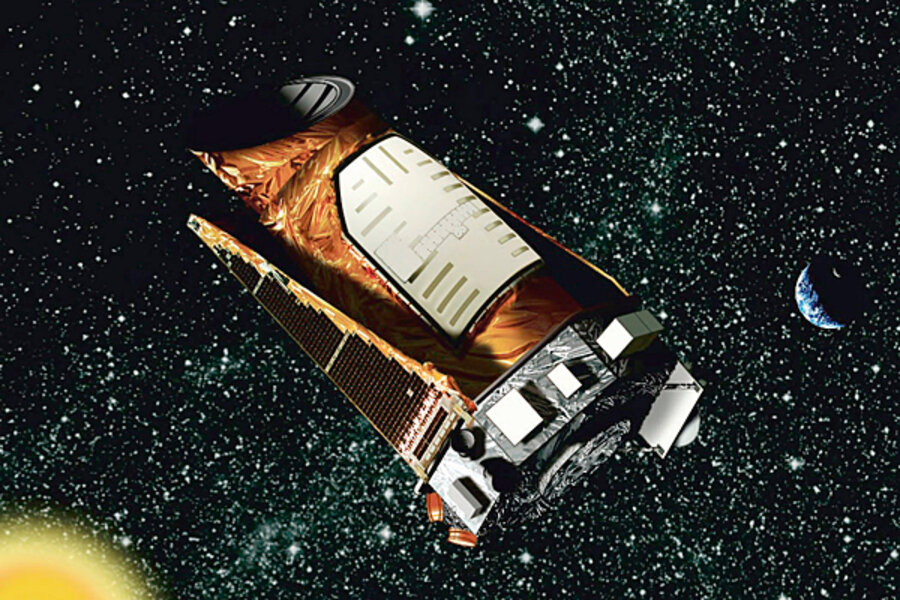What's next for Kepler? NASA's storied planet hunter is looking for a job.
Loading...
NASA's Kepler spacecraft, which has spent the last four years conducting a pioneering hunt for planets orbiting other stars, is hunting for a new job.
Mechanical problems that cropped up last July have prevented the craft from pointing itself as precisely as mission scientists require. Engineers haven't been able to fix the problems, despite what NASA officials call "the extraordinary effort" by the Kepler team to do so.
But the craft's scientific instruments are still functioning, and Kepler's tanks appear to have enough thruster fuel to last for a few more years, mission managers say.
Kepler could be drafted to hunt for asteroids and comets, it could search for supernovae, or it could be used in conjunction with ground-based telescopes to look for additional extrasolar planets using an approach known as gravitational micro-lensing.
Much depends on a thorough assessment of the craft's ability to point itself with enough stability to tackle these or other projects, says William Borucki, the mission's lead scientist, who is based at NASA's Ames Research Center at Moffett Field, Calif.
"We need to understand what the spacecraft can do," he said in a briefing Thursday to announce the end of data-gathering for the Kepler mission. On Aug. 2, the team asked astronomers for their ideas on an encore career for the spacecraft. The Kepler team expects to see the white papers outlining those ideas in a few weeks.
But don't proclaim the original mission over. To Dr. Borucki those are fighting words.
"You make the observations. You analyze the observations. The mission's done when you finish your analysis and have a result," he said emphatically.
Much remains to be done with the spacecraft’s observations. The team has confirmed 135 planets so far, with more than 3,500 planet candidates yet to analyze. Among those, the team has identified several hundred Earth-sized planet-candidates.
Using Borucki's criterion, the original Kepler mission has some three or four more years to run as scientists sift through the backlog of data for the mission's top prize: Identifying an Earth-mass planet orbiting a sun-like star at an Earth-like distance – within the star's so-called habitable zone.
To do that, Kepler stared at a field of more than 145,000 stars virtually non-stop for four years. Its single instrument, a photometer, was designed to detect tiny variations in a star's light that occur as a planet eclipses, or transits, the star. At the same time, the craft had to detect small natural fluctuations in a star's output to help researchers distinguish between a planet and a reading that amounted to a so-called false positive.
This required extraordinary precision in pointing the craft while using the minimum amount of fuel to keep it properly oriented as it orbited the sun.
Engineers designed the craft to achieve that precision using reaction wheels, which act like gyroscopes. The craft needed three of four wheels to be functional in order to retain the desired precision in pointing. One failed in July 2012. A second went AWOL in May.
Last week, engineers tried to get the second of the two balky wheels to play nicely with the two remaining good ones to control the craft, said Charles Sobek, Kepler's deputy project manager. Initially all three worked, but soon friction began to increase in the suspect wheel.
In essence, it was good for short runs, but not for the long periods that would be needed for precision pointing over long periods of time, he explained, likening it to a bum wheel on a chopping cart – it wobbles, you back up the cart, and it works fine for another four or five steps before the wobble returns.
The end to this phase of the spacecraft's activities is something of a disappointment, Borucki allows, given that the mission had been extended four years beyond the initial end date in November 2012.
Still, "the Kepler mission has been spectacularly successful," he said. Heading into the mission, no one knew how many Earth-size planets there might be in the galaxy.
Now, he said, "we know that the galaxy is filled to the brim with planets ... and a large fraction of these planets are small."
Over the new few years, as researchers examine the remaining planet candidates, "we expect hundreds, maybe thousands of new planet discoveries, including the long-awaited Earth-size orbiting a star as hot as our sun."








